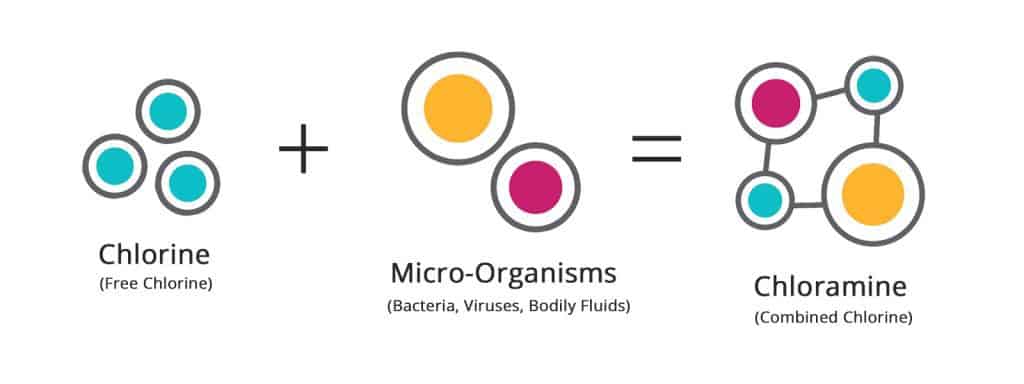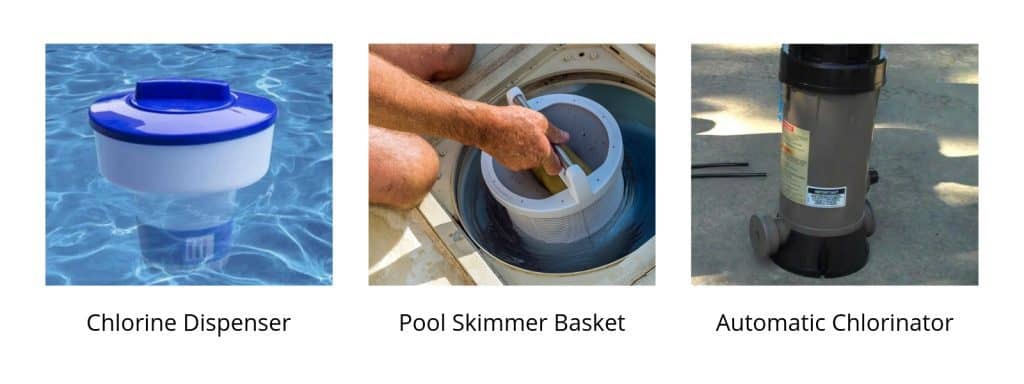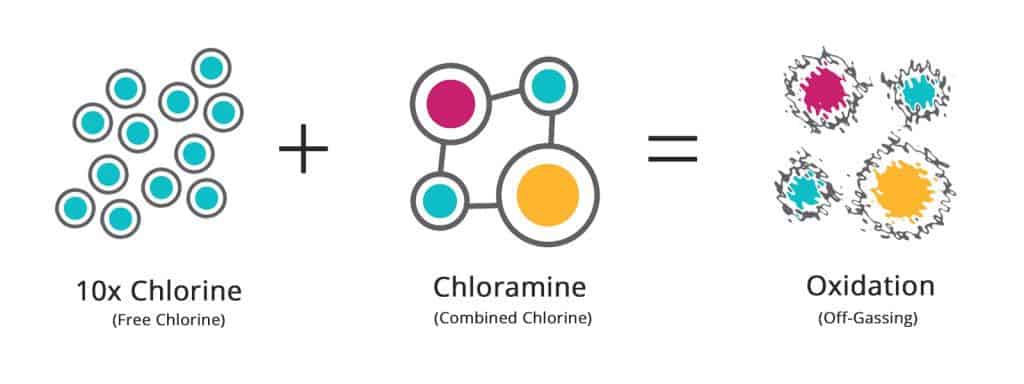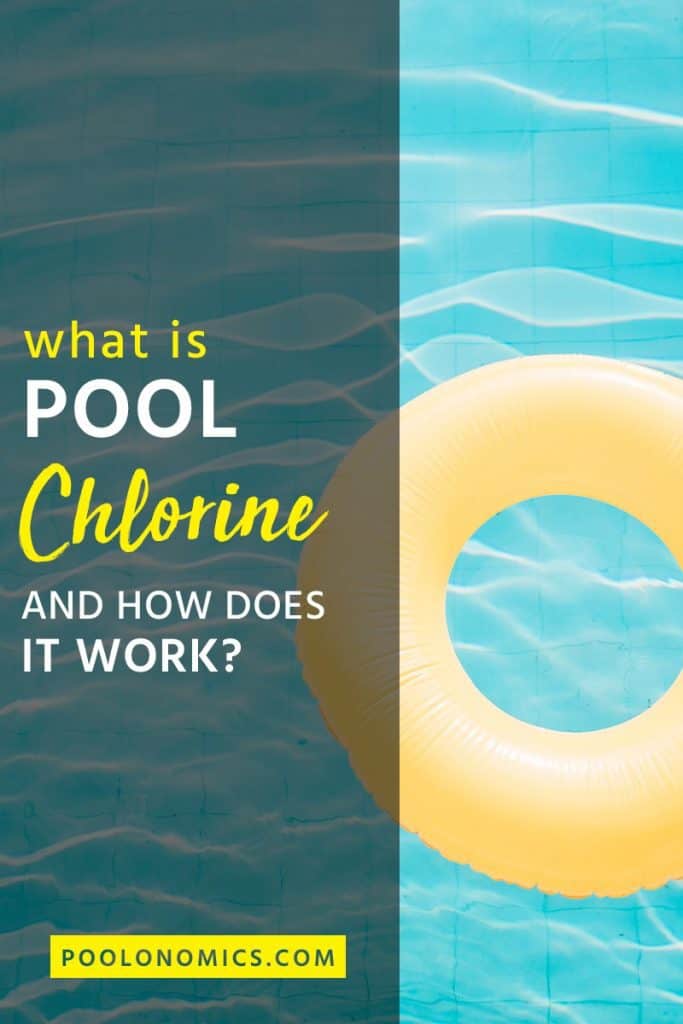Let’s face it, pool maintenance is no walk in the park, especially when it comes to learning the processes and ingredients that contribute to a clean and friendly pool.
If you’re reading this, you probably know that chlorine is one of the most important ingredients — so understanding what it is, how it works, why you need it, and how to use it effectively is a high priority.
This guide will arm you with all the pool chlorine knowledge you need to keep your pool water in pristine condition, so let’s get right into it.
What Is Pool Chlorine, Exactly?
Chlorine is a chemical sanitizer that typically comes in either tablet, powder or liquid form, which is then prepped and added to your swimming pool in order to keep your pool water clean and safe to swim.
Chlorine fights against everything from:
- Micro-organisms carrying diseases such as cholera, hepatitis A, and dysentery
- Poo, pee, sweat, saliva, and dirt from other people swimming in the pool
- Dirt and debris from the wider environment
- Any growth and spread of algae
So far so simple, but how does it actually work?
Once the chlorine is added to your water, it forms a new substance called ‘hydrochloric acid’ which disables harmful bacteria, viruses and other microscopic dangers by combining with them. Combined chlorine is also known as chloramine.

And not to worry, the doses of hydrochloric acid being described here are far less harmful to us humans, and certainly less harmful than letting those microscopic nasties live and breed freely in your pool.
Finally, this reaction works best under the right pH conditions so you’ll want to keep a close eye on your levels when using chlorine. Sunlight also speeds up the process, meaning you’ll burn through more chlorine if your pool is constantly in the sun.
The Different Forms of Chlorine
I already mentioned that chlorine used in swimming pools comes in either tablet, powder or liquid form, but there are some nuances you should be aware of before pulling the trigger on a purchase.
Each form has benefits and drawbacks, as well as different price-points, applications and overall effectiveness in specific situations. There’s no one-size fits all.

1. Chlorine Tablets
Chlorine tablets are typically used with a dispenser that allows them to be released into your pool consistently over time. This makes it the easiest form of chlorine to use, and the one we recommend to most domestic pool owners.
Tablets can also contain other helpful substances such as algaecide and water clarifier, removing the need to purchase and add these independently.
2. Powdered Chlorine
Powdered chlorine is also referred to as “chlorine granules” and is either sprinkled evenly into your pool, or dissolved in a separate container before being poured into your pool water.
This is a more hands on approach, but it also gives you more granular (pun intended) control over your chlorine levels.
3. Liquid Chlorine
Liquid chlorine is typically the cheapest option and is poured directly into the pool, but with pH level of around 13 it does require careful balancing of your pool water which can increase costs.
This is a popular option for larger, commercial pools because it can be quickly added in large quantities.
The Different Types of Chlorine
Whether you choose to go with tablet, powdered or liquid chlorine, know that these come in either unstabilized and stabilized variants.
Without turning this into a chemistry lesson, I’d like to cover the basics when it comes to the different types of chlorine, and more importantly what each one means for you as a swimming pool owner.
1. Unstabilized Chlorine
Unstabilized chlorine is chlorine that has not been mixed with cyanuric acid (CYA), a chemical that shields your chlorine from the sun’s ultra-violet (UV) rays which decreases the overall burn-rate of your dosage.
Since not all swimming pools are outdoors or exposed to the sun, unstabilized chlorine can be used to the same effect in the right circumstances. Besides, there’s nothing stopping you from adding cyanuric acid to your pool if needed.
Finally, since this type of chlorine has a shorter lifespan than stabalized chlorine, it can also be used in large doses to shock your pool, or even as an emergency top up to quickly restore falling chlorine levels.
In summary:
- It has a fast burn-rate when exposed to the sun
- It’s typically used with indoor or shaded pools
- It can be used to shock your pool or for top ups
Unstabilized Chlorine Compounds
To further complicate things, there are 3 different chlorine compounds you can buy that fall into the unstabilized category:
- Sodium Hypochlorite. Also called “Sodium Hypo”, this comes in liquid form and contains around 10-12% available chlorine. It’s typically added to pools through a chemical feeder and is most commonly used in large/commercial pools since it can be easily added in large volumes.
- Lithium Hypochlorite. Also called “Lithium Hypo”, this comes in granular form and contains around 35% available chlorine. It has a fast dissolve-rate which makes it good for shocking, but also prevents a bleaching effect on vinyl and fibreglass pools. It is, however, a little on the pricey side compared to other types.
- Calcium Hypochlorite. Also called “Calcium Hypo”, this comes in granular or tablet form and contains around 60% available chlorine. This is the most popular type.
2. Stabilized Chlorine
You guessed it, stabilized chlorine is chlorine that has been mixed with cyanuric acid (CYA), protecting your chlorine from the sun’s ultra-violet (UV) rays which decreases the overall burn-rate of your dosage.
Again, the added acid is only important for swimming pools that are frequently exposed to the sun, and having it mixed in with your chlorine just makes your life easier when it comes to dosages.
Speaking of dosages, however, you’ll still need to keep a close eye on your cyanuric acid levels over time. If your acid levels spike, you’ll also need more chlorine to keep your chemicals balanced and working efficiently.
In summary:
- It has a slow burn-rate when exposed to the sun
- It’s typically used with outdoor pools
- It’s easier to manage but you still need to watch your cyanuric acid levels
Stabilized Chlorine Compounds
This time there are only 2 different chlorine compounds you can buy that fall into the stabilized category:
- Sodium Dichlor. Also simply called “Dichlor”, this comes in granular form and contains around 56-62% available chlorine. Unlike Lithium Trichlor (below), this type slightly reduces the pH and total alkalinity of your pool water.
- Lithium Trichlor. Also simply called “Trichlor”, this comes in powder and sometimes tablet or granular form, and it contains around 90% available chlorine. This is a solid, dry form with the highest chlorine content.
Methods of Adding Chlorine To Your Pool
How to properly add chlorine to a pool is a common question from new pool owners, and you may find conflicting advice on the best way to approach it.
Below I’ll cover the 3 methods you can use to add chlorine to your pool, the pros and cons of each, and which one I personally recommend above all.

1. A Floating Chlorine Dispenser
A floating chlorine dispenser is a little container for chlorine pucks that floats around the surface of your pool, slowly dissolving and releasing the chlorine into the water.
This is the cheapest and easiest way to add chlorine to your pool, but you guessed it, it’s also the least effective way. Since it floats on the surface, the lack of circulation means it doesn’t disperse very well and ultimately leads to poor sanitation.
These things also tend to get stuck behind pool ladders or steps, at which point the chlorine being released starts to build up in one area of the pool. In fact, this high concentration near the edges can bleach your pool liners. As you can imagine, they’re not ideal to have in the pool when people are using it, either.
2. Your Pool’s Skimmer Basket
Your filter system is designed to pull in, clean and circulate your pool water. Of course, an integral part of that system is your skimmer, and the skimmer can be leveraged when it comes to adding chlorine to your pool.
All you need to do is add chlorine to your pool skimmer (preferably tablets), and you can sit back and let it do the work of sending the dissolved chlorine through your filter system and our into your pool water.
This is more effective than a floating dispenser and is a much better option overall, but you will need to remove the chlorine from your skimmer when your pump is off, otherwise you’ll get a high concentration of chlorinated water which can be corrosive.
3. An Automatic Chlorinator
An automatic chlorinator attaches to your filter system and administers a measured amount chlorine to your pool constantly, on autopilot.
All you need to do is keep it topped up with chlorine (again, preferably tablets) and it will output as much chlorine as you tell it to via the dial. This setup will also allow you to pump large burst of chlorine into your water, or simply regulate it over time.
Using an automatic chlorinator is the best method if you can afford to invest the money, but you won’t be surprised to know it’s also the most expensive of the three.
Shocking Your Pool
Remember when I told you chlorine combines with the harmful stuff in your pool to create new compounds called chloramines?
Well, as more chlorine is added to your pool, these chloramines (also called combined chlorine) begin to build up in the water.
This build-up is a problem because chloramine:
- Gets in the way of chlorine, slowing down sanitation.
- Causes skin and eye irritation in swimmers.
- Is responsible for that overpowering “chlorine smell”.
The solution is to shock your pool. Ironically, this means adding even more chlorine. At least 10x the chloramine level to reach “breakpoint chlorination” in the water, which is when chlorine begins to rip apart the chloramine molecules.

This ripping apart is known as “oxidation”, and it’s what forces the chloramine to off-gas and ultimately leave your pool. If chloramine is your fallen army, you can think of shocking as sending in the cleanup crew.
Be aware that if you don’t use enough chlorine to reach breakpoint you can actually make the problem worse as it will only create more chloramines. If that happens, you’ll need even more chlorine to reach breakpoint.
Pool shocking deserves an entire article by itself, so I’ll refer you to my pool shock review and guide for more detailed information on this process.
Chlorine Alternatives
It’s true that chlorine remains the cheapest and most widely used chemical when it comes to pool water sanitation, but I’d be lying if I said it was only kid on the block.
While the chlorine in your pool is perfectly safe when used correctly, it does irritate your eyes, dry out your skin, and can lead to a pretty unpleasant smell when imbalanced. Some people are bothered by these side-effects and wish to try an alternative.
Let’s briefly look at some of the other ways you can sanitize your swimming pool water without having to rely on chlorine.
Bromine
Bromine is a close cousin of chlorine, typically bought in tablet form and functions in much the same way on a molecular level. So yeah… if you have allergies or other issues with chlorine, you may find bromine equally problematic.
There are some notable benefits to using bromine, however. For example, it doesn’t give off that infamous chlorine smell, it’s softer on your skin, and it’s actually more effective at sanitizing your pool which means smaller, less frequent top ups.
The drawback is price. It’s more expensive than chlorine which is why people tend to overlook it. However, since maintaining your pool requires less volume of bromine, the cost difference actually isn’t all that drastic.
Finally, bromine is unstabilized which means the sun will chew through it much faster than stabilized chlorine, which is also why it’s typically used for indoor pools and hot tubs.
Biguanide
Biguanide, which goes by brand names such Baquaisil and Soft Swim, is a peroxide-based sanitizer that comes in liquid form. This is a common alternative to chlorine/bromine and it gives the water a noticeably softer feel in comparison.
This stuff is very effective at killing bacteria, but has trouble dealing with organic matter that will eventually become resistant to it’s effects. For that reason, regular shocking with hydrogen peroxide is required to pick up the slack.
Those with chlorine sensitivity will likely find comfort with this alternative, though it does come at a price as it’s significantly more expensive than both chlorine and bromine. Oh, and improper balancing of biguanide quickly leads to cloudy pool water. It’s a thing.
Mineral System
A mineral system uses an ionizer to sanitize the water by releases silver and copper ions that fight against bacteria, viruses and algae. This runs on a mineral cartridge system which should be replace with a new cartridge every season.
While some consider this an alternative to chlorine, a mineral system works much slower and often relies on a small dose of chlorine to keep up the pace. Reducing chlorine levels can still be enough to resolve irritation issues, so it can be worth considering.
Of course, the seasonal replacements of mineral cartridges and light applications of chlorine means that running costs work out a little more expensive than what you can expect from a chlorine-only pool
Salt System
Saltwater pools feed salt (which is just regular ol’ table salt) through a saltwater generator which then turns the salt crystals into chlorine. Basically, a saltwater pool is still uses chlorine as a sanitizer and again isn’t really an alternative.
That being said, there are some differences that make a salt system more desirable. For example, you no longer need to buy or handle chlorine chemicals, you just top up with table salt which is much cheaper. Also, the salt system maintains the correct chlorine levels on autopilot. Easy-peasy.
While there are savings to be had long-term, the biggest downside to this approach to pool sanitation is the upfront cost as a saltwater system and installation process can set you back a pretty penny.
That’s A Wrap!
There you have it, a complete beginners guide to pool chlorine, one of the essential ingredients to a clean, clear and healthy pool.
As always, don’t forget to wear the right protective equipment when handling pool chemicals such as chlorine. Stay safe and happy swimming!
Share on Pinterest

